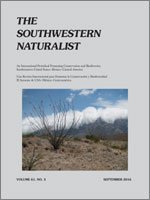Quantifying movement of nonnative fish predators is needed to understand the spatial and temporal scale of their impacts on native species. We used radiotelemetry to document nonnative flathead catfish (Pylodictis olivaris) movement at hourly, daily, and seasonal time scales from May 2014 to June 2015 in the upper Gila River basin, New Mexico. Movement varied among individuals, with a large proportion (45%) moving <100 m from tagging locations, while some others moved substantial distances (7,355–42,840 m) downstream into warmer river reaches before winter. Average nightly movements were typically short (5 m) and no fish moved >80 m in one night. Archival radiotags recovered from three individuals indicated that activity was greatest in summer and autumn during the evening, but we also observed some late-afternoon activity. Additionally, abnormally high activity during 8–12-h periods often coincided with increases in river discharge. Temperature was exponentially correlated with activity, with sharp increases of activity occurring between 17.8° and 19.6°C. Although the majority of flathead catfish in this study only moved short distances, we demonstrated their capacity to travel large distances and showed movements are likely triggered by changes in flow and temperature.
How to translate text using browser tools
1 September 2016
Movement distances and activity of introduced flathead catfish (Pylodictis olivaris) in the upper Gila River basin, New Mexico, and potential impacts on native fishes
Skyler C. Hedden,
Keith B. Gido
ACCESS THE FULL ARTICLE

The Southwestern Naturalist
Vol. 61 • No. 3
September 2016
Vol. 61 • No. 3
September 2016




